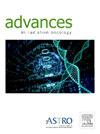Quantification and Dosimetric Impact of Normal Organ Motion During Adaptive Radiation Therapy Planning Using a 1.5 Tesla Magnetic Resonance–Equipped Linear Accelerator (MR-Linac)
IF 2.7
Q3 ONCOLOGY
引用次数: 0
Abstract
Purpose
Patients receiving adaptive magnetic resonance guided radiation therapy (MRgRT) undergo contour modification prior to treatment delivery, which takes 15 to over 60 minutes. We hypothesized that during the time required to create an adaptive MRgRT plan, organ movement will result in dosimetric changes to regional organs at risk (OARs). This study quantifies the dosimetric impact of OAR motion during the time required to perform adaptive MRgRT.
Methods and Materials
Thirty-one patients with pancreatic adenocarcinoma, prostate adenocarcinoma, hepatocellular carcinoma, and oligo-metastases who received MRgRT using a 1.5 Tesla MR-Linac were prospectively enrolled in an open registry imaging trial (NCT03500081). Two magnetic resonance imaging (MRI) studies were acquired predelivery for each MRgRT treatment fraction: an initial “pretreatment” MRI (input to the adaptive evaluation with or without recontouring and replanning process), and a second “verification MRI” (acquired after the recontouring and adaption process and immediately before treatment delivery or “beam-on”). On the verification MRI, normal organs were recontoured offline. Recontoured normal organs included the colon, duodenum, small bowel, and stomach. Differences in OARs between organ positions represented the normal organ movement during the time required for plan adaption. Maximum dose (Dmax), volumetric (V) 0.5 cubic centimeter dose (D0.5cc), 3000 cGy (V30), and 2000 cGy (V20) were calculated from the recontoured verification MRI.
Results
Differences in Dmax, per fraction, for the listed normal organs were as follows: colon/rectum 239.50 cGy (P = .09), duodenum 136.40 cGy (P = .05), small bowel 488.27 cGy (P < .01), and stomach 95.92 (P = .17). Small bowel demonstrated a significant difference in Dmax, D0.5cc, and V30.
Conclusions
Statistically significant differences in small bowel doses are demonstrated as a result of motion during the timing required for adaptive MRgRT. These results reflect the importance of verifying MRI acquisition during adaptive MRgRT to confirm the location of OARs. They also identify the necessity of strategies to account for the dynamic nature of regional OARs.
使用 1.5 特斯拉磁共振直线加速器(MR-Linac)制定自适应放疗计划时正常器官运动的量化和剂量学影响
目的接受自适应磁共振引导放射治疗(MRgRT)的患者在接受治疗前需要进行轮廓修改,这需要15到60多分钟。我们假设,在制定适应性MRgRT计划所需的时间内,器官运动将导致局部危险器官(OARs)的剂量学变化。本研究量化了在进行自适应磁共振成像(MRgRT)所需时间内桨运动的剂量学影响。方法和材料31例胰腺癌、前列腺癌、肝细胞癌和少转移患者使用1.5 Tesla MR-Linac接受MRgRT治疗,前瞻性地纳入了一项开放注册成像试验(NCT03500081)。每个MRgRT治疗部分在分娩前获得两次磁共振成像(MRI)研究:初始“预处理”MRI(输入有或没有重新轮廓和重新规划过程的适应性评估),第二次“验证性MRI”(在重新轮廓和适应过程之后,在治疗交付或“光束”之前获得)。在验证MRI上,正常器官离线重构。重建的正常器官包括结肠、十二指肠、小肠和胃。不同器官位置之间桨形的差异代表了正常器官在计划适应所需时间内的运动。重新轮廓验证MRI计算最大剂量(Dmax)、体积(V) 0.5立方厘米剂量(D0.5cc)、3000 cGy (V30)、2000 cGy (V20)。结果各组正常脏器Dmax的差异分别为:结肠/直肠239.50 cGy (P = 0.09),十二指肠136.40 cGy (P = 0.05),小肠488.27 cGy (P <;.01),胃95.92 (P = .17)。小肠Dmax、D0.5cc和V30有显著差异。在适应性MRgRT所需的时间内,运动导致小肠剂量有统计学上的显著差异。这些结果反映了在自适应MRgRT期间验证MRI采集以确定桨叶位置的重要性。它们还确定有必要制定战略,以说明区域桨叶的动态性质。
本文章由计算机程序翻译,如有差异,请以英文原文为准。
求助全文
约1分钟内获得全文
求助全文
来源期刊

Advances in Radiation Oncology
Medicine-Radiology, Nuclear Medicine and Imaging
CiteScore
4.60
自引率
4.30%
发文量
208
审稿时长
98 days
期刊介绍:
The purpose of Advances is to provide information for clinicians who use radiation therapy by publishing: Clinical trial reports and reanalyses. Basic science original reports. Manuscripts examining health services research, comparative and cost effectiveness research, and systematic reviews. Case reports documenting unusual problems and solutions. High quality multi and single institutional series, as well as other novel retrospective hypothesis generating series. Timely critical reviews on important topics in radiation oncology, such as side effects. Articles reporting the natural history of disease and patterns of failure, particularly as they relate to treatment volume delineation. Articles on safety and quality in radiation therapy. Essays on clinical experience. Articles on practice transformation in radiation oncology, in particular: Aspects of health policy that may impact the future practice of radiation oncology. How information technology, such as data analytics and systems innovations, will change radiation oncology practice. Articles on imaging as they relate to radiation therapy treatment.
 求助内容:
求助内容: 应助结果提醒方式:
应助结果提醒方式:


